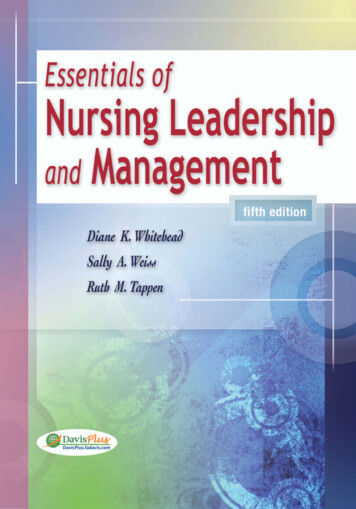
Transcription
PracticePlannersArthur E. Jongsma, Jr., Series EditorThe Speech-LanguagePathologyTreatment PlannerKeith LandisJudith Vander WoudeArthur E. Jongsma, Jr.JOHN WILEY & SONS, INC.
The Speech-LanguagePathologyTreatment Planner
PracticePlanners SeriesTreatment PlannersThe Complete Adult Psychotherapy Treatment Planner, Third EditionThe Child Psychotherapy Treatment Planner, Third EditionThe Adolescent Psychotherapy Treatment Planner, Third EditionThe Addiction Treatment Planner, Second EditionThe Continuum of Care Treatment PlannerThe Couples Psychotherapy Treatment PlannerThe Employee Assistance Treatment PlannerThe Pastoral Counseling Treatment PlannerThe Older Adult Psychotherapy Treatment PlannerThe Behavioral Medicine Treatment PlannerThe Group Therapy Treatment PlannerThe Gay and Lesbian Psychotherapy Treatment PlannerThe Family Therapy Treatment PlannerThe Severe and Persistent Mental Illness Treatment PlannerThe Mental Retardation and Developmental Disability Treatment PlannerThe Social Work and Human Services Treatment PlannerThe Crisis Counseling and Traumatic Events Treatment PlannerThe Personality Disorders Treatment PlannerThe Rehabilitation Psychology Treatment PlannerThe Special Education Treatment PlannerThe Juvenile Justice and Residential Care Treatment PlannerThe School Counseling and School Social Work Treatment PlannerThe Sexual Abuse Victim and Sexual Offender Treatment PlannerThe Probation and Parole Treatment PlannerThe Psychopharmacology Treatment PlannerThe Speech-Language Pathology Treatment PlannerThe Suicide and Homicide Risk Assessment & Prevention Treatment PlannerThe College Student Counseling Treatment PlannerProgress Note PlannersTheTheTheTheTheTheChild Psychotherapy Progress Notes Planner, Second EditionAdolescent Psychotherapy progress Notes Planner, Second EditionAdult Psychotherapy Progress Notes Planner, Second EditionAddiction Progress Notes PlannerSevere and Persistent Mental Illness Progress Notes PlannerCouples Psychotherapy Progress Notes PlannerHomework PlannersBrief Therapy Homework PlannerBrief Couples Therapy Homework PlannerBrief Adolescent Therapy Homework PlannerBrief Child Therapy Homework PlannerBrief Employee Assistance Homework PlannerBrief Family Therapy Homework PlannerGrief Counseling Homework PlannerGroup Therapy Homework PlannerDivorce Counseling Homework PlannerSchool Counseling and School Social Work Homework PlannerChild Therapy Activity and Homework PlannerAddiction Treatment Homework Planner, Second EditionAdolescent Psychotherapy Homework Planner IIAdult Psychotherapy Homework PlannerClient Education Handout PlannersAdult Client Education Handout PlannerChild and Adolescent Client Education Handout PlannerCouples and Family Client Education Handout PlannerDocumentation SourcebooksTheTheTheTheTheTheTheClinical Documentation Sourcebook, Second EditionForensic Documentation SourcebookPsychotherapy Documentation PrimerChemical Dependence Treatment Documentation SourcebookClinical Child Documentation SourcebookCouple and Family Clinical Documentation SourcebookContinuum of Care Clinical Documentation SourcebookComplete PlannersThe Complete Depression Treatment and Homework PlannerThe Complete Anxiety Treatment and Homework Planner
PracticePlannersArthur E. Jongsma, Jr., Series EditorThe Speech-LanguagePathologyTreatment PlannerKeith LandisJudith Vander WoudeArthur E. Jongsma, Jr.JOHN WILEY & SONS, INC.
This book is printed on acid-free paper.Copyright 2004 by Keith Landis, Judith Vander Woude, and Arthur E. Jongsma, Jr. All rightsreserved.Published by John Wiley & Sons, Inc., Hoboken, New Jersey.Published simultaneously in Canada.No part of this publication may be reproduced, stored in a retrieval system, or transmitted in anyform or by any means, electronic, mechanical, photocopying, recording, scanning, or otherwise,except as permitted under Section 107 or 108 of the 1976 United States Copyright Act, without either the prior written permission of the Publisher, or authorization through payment of the appropriate per-copy fee to the Copyright Clearance Center, Inc., 222 Rosewood Drive, Danvers, MA01923, (978) 750-8400, fax (978) 646-8600, or on the web at www.copyright.com. Requests to thePublisher for permission should be addressed to the Permissions Department, John Wiley & Sons,Inc., 111 River Street, Hoboken, NJ 07030, (201) 748-6011, fax (201) 748-6008.Limit of Liability/Disclaimer of Warranty: While the publisher and author have used their best efforts in preparing this book, they make no representations or warranties with respect to the accuracyor completeness of the contents of this book and specifically disclaim any implied warranties ofmerchantability or fitness for a particular purpose. No warranty may be created or extended bysales representatives or written sales materials. The advice and strategies contained herein may notbe suitable for your situation. You should consult with a professional where appropriate. Neither thepublisher nor author shall be liable for any loss of profit or any other commercial damages,including but not limited to special, incidental, consequential, or other damages.This publication is designed to provide accurate and authoritative information in regard to thesubject matter covered. It is sold with the understanding that the publisher is not engaged in rendering professional services. If legal, accounting, medical, psychological or any other expert assistance is required, the services of a competent professional person should be sought.Designations used by companies to distinguish their products are often claimed as trademarks. Inall instances where John Wiley & Sons, Inc. is aware of a claim, the product names appear in initialcapital or all capital letters. Readers, however, should contact the appropriate companies for morecomplete information regarding trademarks and registration.All references to diagnostic codes are reprinted with permission from the Diagnostic and StatisticalManual of Mental Disorders, Fourth Edition, Text Revision. Copyright 2000. American PsychiatricAssociation.For general information on our other products and services please contact our Customer CareDepartment within the United States at (800) 762-2974, outside the United States at (317) 5723993 or fax (317) 572-4002.Wiley also publishes its books in a variety of electronic formats. Some content that appears inprint may not be available in electronic books. For more information about Wiley products, visitour web site at www.wiley.com.Library of Congress Cataloging-in-Publication Data:ISBN 0-471-27504-2Printed in the United States of America.10987654321
To my wife, Jacqueline, my mother, Evelyn, and thememory of my father, Frank—K.L.For all those future speech-language pathologists. Maywisdom and compassion guide all of your interventiondecisions.—J.V.W.To my brother-in-law and coauthor, Keith Landis—aknowledgeable speech therapist and a very kind man of fewwords that are always well chosen.—A.E.J.
CONTENTSPracticePlanners Series PrefaceAcknowledgmentsIntroductionxiiixv1Accent ReductionAlaryngeal SpeechAphasiaApraxiaAugmentative/Alternative CommunicationCerebral PalsyCleft PalateDevelopmental Apraxia of Fluency DisordersHearing ImpairmentInfants at-RiskLanguage Disorders—AdolescentsLanguage Disorders—ChildrenLanguage Disorders—PreschoolersMental ImpairmentPervasive Developmental Disorder—Asperger’s SyndromePervasive Developmental Disorder—AutismPhonological DisordersRight Hemisphere DysfunctionTracheostomy and Ventilator DependenceTraumatic Brain 0149159169179188197207216xi
xiiCONTENTSTraumatic Brain Injury—PediatricVoice Disorders227238Appendix A: Annotated Bibliography for ProfessionalsAppendix B: Bibliotherapy ReferencesAppendix C: Index of DSM-IV-TR Codes Associatedwith Presenting Problems248262267
PRACTICEPLANNERS SERIES PREFACEThe practice of psychotherapy, as well as other therapies, has a dimension thatdid not exist 30, 20, or even 15 years ago—accountability. Treatment programs,public agencies, clinics, and even group and solo practitioners must now justifythe treatment of patients to outside review entities that control the payment offees. This development has resulted in an explosion of paperwork. Cliniciansmust now document what has been done in treatment, what is planned for thefuture, and what the anticipated outcomes of the interventions are. The booksand software in this PracticePlanners series are designed to help practitionersfulfill these documentations requirements efficiently and professionally.The PracticePlanners series is growing rapidly. It now includes not onlythe original The Complete Adult Psychotherapy Treatment Planner, ThirdEdition, The Child Psychotherapy Treatment Planner, Third Edition, and TheAdolescent Psychotherapy Treatment Planner, Third Edition, but alsoTreatment Planners targeted to specialty areas of practice, including:addictions, juvenile justice/residential care, couples therapy, employeeassistance, behavioral medicine, therapy with older adults, pastoral counseling,family therapy, group therapy, neuropsychology, therapy with gays andlesbians, special education, school counseling, probation and parole, therapywith sexual abuse victims and offenders, and more.Several of the Treatment Planner books now have companion ProgressNotes Planners (e.g., Adult, Adolescent, Child, Addictions, Severe and Persistent Mental Illness, Couples). More of these planners, which provide a menu ofprogress statements that elaborate on the client’s symptom presentation and theprovider’s therapeutic intervention are in production. Each Progress NotesPlanner statement is directly integrated with “Behavioral Definitions” and“Therapeutic Interventions” items from the companion Treatment Planner.The list of therapeutic Homework Planners is also growing from theoriginal Brief Therapy Homework to Adult, Adolescent, Child, Couples,Group, Family, Addictions, Divorce, Grief, Employee Assistance, andSchool Counseling/School Social Work Homework Planners. Each of thesebooks can be used alone or in conjunction with their companion TreatmentPlanner. Homework assignments are designed around each presentingproblem (e.g., Anxiety, Depression, Chemical Dependence, Anger Management, Panic, Eating Disorders), which is the focus of a chapter in itscorresponding Treatment Planner.xiii
xivPRACTICEPLANNERS SERIES PREFACEClient Education Handout Planners, a new branch in the series, provides brochures and handouts to help educate and inform adult, child, adolescent, couples, and family clients on a myriad of mental health issues, aswell as life-skills techniques. The list of presenting problems for whichinformation is provided mirrors the list of presenting problems in theTreatment Planner of the title similar to that of the Handout Planner. Thus,the problems for which educational material is provided in the Child andAdolescent Client Education Handout Planner reflect the presenting problems listed in The Child and The Adolescent Psychotherapy TreatmentPlanner books. Handouts are included on CD-ROMs for easy printing andare ideal for use in waiting rooms, at presentations, as newsletters, or asinformation for clients struggling with mental illness issues.In addition, the series also includes TheraScribe , the latest version ofthe popular treatment planning, clinical record-keeping software. TheraScribe allows the user to import the data from any of the TreatmentPlanner, Progress Notes Planner, or Homework Planner books into thesoftware’s expandable database. Then the point-and-click method can create a detailed, neatly organized, individualized, and customized treatmentplan along with optional integrated progress notes and homeworkassignments.Adjunctive books, such as The Psychotherapy Documentation Primer,and The Clinical, Forensic, Child, Couples and Family, Continuum ofCare, and Chemical Dependence Documentation Sourcebook containforms and resources to aid the mental health practice management. Thegoal of the series is to provide practitioners with the resources they need toprovide high-quality care in the era of accountability—or, to put it simply,we seek to help you spend more time on patients, and less time onpaperwork.ARTHUR E. JONGSMA, JR.Grand Rapids, Michigan
ACKNOWLEDGMENTSMany authors say that writing a book is a protracted exercise in loneliness.I am happy to report that this was not the case in the writing of this planner. From start to finish, I enjoyed the encouragement and support of several extraordinary people who made this project a truly collaborativeeffort. Indeed, without their help, I would not have had the stamina to seeit to the end. Special thanks are due to Art Jongsma for proposing the project and guiding it, with great patience and good humor, to its conclusion.He is an ideal editor. Thanks are also due to Judy Vander Woude, anenviable combination of scholar and clinician. I learned greatly from hercriticisms and insights, and I am a better clinician because of ourcollaboration. Jen Byrne’s quietly meticulous work transformed mywoeful attempts at word processing into beautifully readable text. Thanks,Jen. Finally, I would like to thank Peggy Alexander and the editorial staffat John Wiley & Sons for being willing to take a dare with this project,opening a new door for the Treatment Planner Series. Again, thank youall.K.L.A hearty thank you to Art Jongsma for his vision and patient editing of thisproject and to Jen Byrne, Dr. Jongsma’s manuscript assistant, for keepingtrack of all those editorial changes with her always cheerful e-mails. Aspecial note of gratitude to Keith Landis, whose expertise in adult andmedical speech pathology complemented my work in the child and schoolrelated areas. To my friends and colleagues who, as seasoned speechlanguage pathologists, provided invaluable feedback on the content ofthese chapters. Finally, I would like also to thank Peggy Alexander and theeditorial staff at John Wiley & Sons for their willingness to enthusiastically support this work.J.V.W.xv
xviACKNOWLEDGEMENTSMany thanks to Keith Landis and Judy Vander Woude for their fine workand openness to suggestions throughout the writing exercise. This was atrue cooperative venture in which they led me through the maze of speechlanguage terms and therapeutic interventions while I shaped the contentinto our PracticePlanners style and format.Jen Byrne’s skills continue to be indispensable in her manuscriptpreparation. Thanks again, Jen. David Bernstein has joined the editorialteam at Wiley and I welcome him aboard. He joins Cris Wojdylo, PeggyAlexander, and Judi Knott, a support staff who have carried on thePracticePlanners series most capably.A.E.J.
INTRODUCTIONPLANNER FOCUSThe Speech-Language Pathology Treatment Planner is designed forspeech-language pathologists who provide treatment for those with communication disorders. The Planner includes those areas most frequentlyrecognized as our scope of practice by the American Speech-LanguageHearing Association. Although it is not an exhaustive list, the most common challenges for individuals with various communication disorders areaddressed.Interventions are designed to offer the speech-language pathologist avariety of functional and meaningful strategies to improve clients’ communication skills. Emphasis is always on enhancing the strengths of clients and furthering their functional communication skills, regardless of thetypes and severities of their disability.With the advent of managed care, treatment planning and outcomemeasurements are increasingly important in speech-language pathologypractices. Managed care systems expect documented efficient and effective treatment for clients in a restricted time period. Treatment plans areexpected to be well documented with clearly delineated outcomes.Speech-language pathologists in settings such as hospitals, home healthcare, rehabilitation, and private practice are expected to use effective highquality treatment plans delivered in a relatively limited time frame. Ourpurpose in writing this book is to clarify, simplify, and accelerate the treatment planning process for novice speech-language pathologists and toremind more expert speech-language pathologists of best-practice assessment and intervention strategies and approaches.TREATMENT PLAN UTILITYDetailed, written treatment plans benefit not only the client, speechlanguage pathologist, rehabilitation team, insurance community, and1
2THE SPEECH-LANGUAGE PATHOLOGY TREATMENT PLANNERtreatment agencies but also the overall speech pathology profession. Theclient is served by the written plan because it clearly outlines the essentialoutcomes of treatment. The client and significant others no longer wonderwhat the goals of therapy are; the client becomes an integral part of thetreatment process by collaboratively designing the general treatmentapproach and specific goals with the speech-language pathologist. Boththe client and the speech-language pathologist work with explicitly statedobjectives and corresponding interventions. Most important, since needscan change as the client’s circumstances change, the treatment plan mustbe viewed as a dynamic document that can, and must, be updated andadapted to address the client’s specific communicative needs.Clients and speech-language pathologists benefit from treatment plansbecause explicit plans force them to think carefully about therapy outcomes and ultimately be accountable for their time. Behaviorally stated,measurable objectives clearly focus the treatment endeavor. Clear objectives allow the client to channel effort into specific changes that will leadto the long-term goal of functional communication. Therapy is no longer avague contract that seems to focus on meaningless discrete skills. Instead,both clients and speech-language pathologists are concentrating on explicitly stated objectives using specific interventions.Speech-language pathologists are aided by treatment plans becausethey are forced to think analytically and critically about therapeutic interventions that are best suited to help clients attain objectives. Speechlanguage pathologists have always been trained to follow a formalizedplan for the treatment process. Now this Planner will provide an easierway for speech-language pathologists to attend to the techniques, approaches, and measurable targets that form the basis for interventions.Speech-language pathologists benefit also from clear documentation oftreatment which provides a measure of added protection from possible client litigation. Malpractice suits are increasing in frequency, and insurancepremiums are soaring. The first line of defense against allegations is acomplete clinical record detailing the treatment process. The written, individualized, formal treatment plan, which is the guideline for intervention,that has been reviewed and signed by the clients and/or parents and coupled with problem-oriented progress notes is a powerful defense againstexaggerated or false claims.A well-crafted treatment plan that clearly stipulates presentingproblems and intervention strategies facilitates the treatment processcarried out by speech-language pathologists and other team members in avariety of treatment settings. Good communication among team membersabout implementation of approaches and responsibility for intervention iscritical. A thorough treatment plan stipulates in writing the details ofobjectives, various interventions (individual therapy, group therapy, con-
INTRODUCTION3sultative, transdisciplinary, community or home-based, etc.) to be used andwho will implement those interventions.Every treatment agency or institution is constantly looking for ways toincrease the quality and uniformity of documentation in the clinicalrecord. The standardized, written treatment plan with problem definitions,goals, objectives, and interventions in every client’s file enhances the uniformity of documentation and eases the task of record reviewers insideand outside agencies. The demand for accountability from third-partypayers and health maintenance organizations is partially satisfied by thewritten treatment plan and progress notes. Managed care systems aredemanding structured therapeutic contracts that have measurable objectives and explicit interventions. Speech-language pathologists cannotavoid the move toward being more accountable to those outside the treatment process.The speech-language pathology profession stands to benefit from theuse of precise, measurable objectives to evaluate success in treatment.With detailed treatment plans, outcome data can be more easily collectedfor interventions that are effective in achieving specific goals.DEVELOPING A TREATMENT PLANThe process of developing a treatment plan involves a logical series ofsteps that build on each other, much like constructing a house. Thefoundation of any effective treatment plan is the data gathered in a comprehensive transdisciplinary evaluation. As part of the process prior todeveloping the treatment plan, speech-language pathologists carefullylisten to and understand the client’s struggles with communication challenges, physical challenges, coping skills, self-esteem, family issues,social networks, occupational stressors, and so forth. The assessment datashould be drawn from a variety of sources, which can include developmental and social history, standardized assessments, conversational samples, criterion-referenced evaluations, physical exams, clinical interviews,psychoeducational testing, psychiatric consultation, and medical consultations. The integration of the data by the speech-language pathologistsand/or the transdisciplinary treatment team is critical for understanding theclient and his or her needs. We have identified six specific steps for developing an effective treatment plan based on assessment data.Step One: Problem SelectionAlthough the client and/or his or her parents may discuss a variety ofissues during the assessment, the speech-language pathologists must focus
4THE SPEECH-LANGUAGE PATHOLOGY TREATMENT PLANNERthe treatment process on the most significant problems. Usually, a primarydeficit will surface, and secondary deficits may also be evident. Otherproblems may have to be set aside as not urgent enough to require simultaneous treatment. An effective treatment plan can deal with only a fewselected deficits at a time or treatment will lose its direction. A variety ofspecific speech and language disorders are presented as chapter titleswithin The Speech-Language Pathology Treatment Planner. The speechlanguage pathologists may select disorders that most accurately representthe client’s current needs.It is important to consider the opinions of clients (as appropriate,depending on the client’s age and mental status) and significant others toprioritize communicative issues and other related disabilities. A client’smotivation to participate in and cooperate with the treatment processdepends, to some extent, on the degree to which treatment addresses his orher greatest needs and how treatment goals directly relate to improvementsin his or her communication in everyday life.Step Two: Problem DefinitionEach individual client presents with unique characteristics that reveal howa problem behaviorally impacts communication in his or her life. Therefore, each problem that is selected for treatment focus requires a specificdefinition about how it is evidenced in that particular client. Turn to thechapter that best describes the identified or suspected disability of the client. Select the statements from the behavioral definitions listed at the beginning of the chapter that appear most descriptive of the client’s needs.Step Three: Goal DevelopmentThe next step in treatment plan development is setting broad goals for theresolution of the target communicative problem. The statements need notbe crafted in measurable terms but can be global, long-term goals that indicate the desired positive outcomes of treatment. The Planner suggestsseveral possible goal statements for each problem, but only one statementis required in a treatment plan.Step Four: Objective ConstructionIn contrast to long-term goals, short-term objectives must be stated inbehaviorally measurable language. It must be clear when the client hasachieved the established objectives; therefore vague, subjective objectivesare not acceptable. The objectives presented in this Planner are designed
INTRODUCTION5to meet the demand for measurable objectives that lead to measurabletreatment outcomes. Alternatives are presented to allow construction of avariety of treatment plan possibilities for the same presenting problem.The speech-language pathologists must exercise professional judgmentconcerning objectives that are most appropriate for a given client.Each objective should be developed into a step toward attaining thebroad treatment goal. In essence, objectives can be thought of as a seriesof steps that, when completed, will result in the achievement of the longterm goal. There should be at least two objectives for each problem, butthe clinician may construct as many as necessary for goal achievement.Target attainment dates may be listed for each objective. New objectivesshould be added to the plan as the individual’s treatment progresses. Whenall the necessary objectives have been achieved, the client should haveresolved the target deficit successfully.Step Five: Intervention CreationInterventions are the actions of the speech-language pathologists designedto help the client complete the objectives. There should be at least oneintervention for every objective. If the client does not accomplish the objective after the initial intervention, new interventions should be added toplan.Interventions should be selected on the basis of the client’s needs anddrawn from the speech-language pathologist’s full therapeutic repertoire.This Planner contains interventions from a broad range of therapeuticapproaches, including cognitive, dynamic, behavioral, or family-orientedapproaches. Many interventions are based on the published work of otherprofessionals. We gave credit to those professionals for their interventionsuggestions in the annotated bibliography in Appendix A, which isorganized by disability or disorder. Other interventions may be written bythe speech-language pathologists to reflect his or her training and experience. The addition of new problems, definitions, goals, objectives, andinterventions to those found in the Planner is encouraged to add to thedatabase for future reference and use.Some suggested interventions listed in this Planner refer to specificbooks that can be provided to the client or the client’s parents for additional information, as located in Appendix B.Step Six: Diagnosis DeterminationThe determination of an appropriate diagnosis is based on an evaluation ofthe client’s complete clinical presentation. The speech-language pathologist must compare the client’s communicative, behavioral, cognitive,
6THE SPEECH-LANGUAGE PATHOLOGY TREATMENT PLANNERemotional, and physical symptoms to the criteria for diagnosis of acommunication disorder condition as described in DSM-IV-TR. Diagnosisis a reality that exists in the world of health care, and it is a necessity forthird-party reimbursement. Recently, managed care agencies are moreinterested in behavioral indices that are exhibited by the client than in theactual diagnosis.Several speech-language disabilities or disorders do not have specificDSM-IV-TR conditions and, thus, have been listed as Communication Disorder Not Otherwise Specified (NOS). Even so, the speech pathologist’scomplete understanding of the client assessment data will contribute to themost reliable, valid diagnosis. An accurate assessment of behavioral indicators will also contribute to more effective treatment planning.HOW TO USE THIS PLANNERThe Speech-Language Pathology Treatment Planner was developed as atool to aid speech-language pathologists in writing a treatment plan that isclear, specific, and highly individualized according to the followingprogression:1. Choose one presenting problem (Step One) you have identifiedthrough a preliminary assessment process. Locate the corresponding page number for the problem in the Planner’s table of contents.2. Select two or three of the listed behavioral definitions (Step Two)and record them in the appropriate section on your treatment planform. Feel free to add your own definitions if you determine thatyour client’s behavioral manifestation of the identified problem isnot listed.3. Select a single long-term goal (Step Three) and again write theselection, as it written in the Planner, or in a modified form, in thecorresponding area of your own treatment form.4. Review the listed objectives for this problem and select the onesthat you judge to be clinically indicated for your client (Step Four).Remember, it is recommended that you select at least two objectives for each problem. Add a target date or the number of sessionsallocated for the attainment of each objective.5. Choose relevant interventions (Step Five). The Planner offers suggested interventions related to each objective in parentheses following the objective statement, but do not limit yourself to thoseinterventions. The entire list is eclectic and may offer options thatare more tailored to your theoretical approach or preferred way ofworking with clients. You may refer also to the annotated bibliography at the end of the Planner for additional sources related to the
INTRODUCTION7interventions. Also, just as with definitions, goals, and objectives,there is space for you to enter your own interventions into thePlanner. This allows you to refer to these entries when you create aplan around this problem in the
Adolescent Psychotherapy Treatment Planner, Third Edition, but also Treatment Planners targeted to specialty areas of practice, including: addictions, juvenile justice/res











